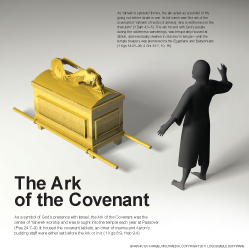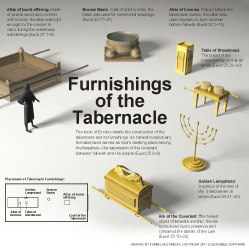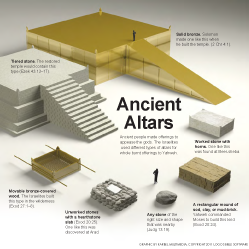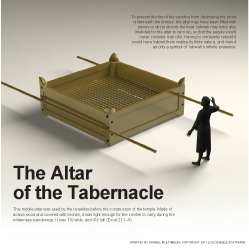4:1–49 The Levitical clans—the Gershonites, Kohathites, and Merarites—were counted and their duties were outlined in Num 3. This chapter provides a count of the Levites eligible for service and reiterates their responsibilities. While no new information is given about the duties of the Gershonites and Merarites (vv. 21–33; compare 3:25–26, 33–37), this chapter explains in more detail how the Kohathites should carry out their duties (vv. 1–20). The Kohathites are singled out here because they are responsible for carrying the sacred furnishings of the tabernacle—a responsibility with more inherent danger (3:27–32). |
4:2 Take a census of This chapter is a census of all the Levites eligible for active service just as the census in ch. 1 was a count of all Israelites eligible for military service.
4:3 thirty years old and above, up to fifty years old Twenty-five is the age at which Levites enter their service to Yahweh (8:24), and 50 is the age at which the Levites are required to retire (8:25). Each Levite presumably completed five years of supervised service between the ages of 25 and 30 (compare vv. 23, 30).
4:4 concerning the holiness of the sanctuary These items are listed in what follows. Detailed descriptions of individual items can be found in Exod 25–30 (compare Exod 35–40).
4:5–15 This passage describes the procedures for dismantling and preparing the holy objects for transport. The Kohathites carried the objects on their shoulders using poles (Num 4:15; 7:9). |
4:5 Aaron and his sons While the Kohathites carried the objects on their shoulders (vv. 15; 7:9), only Aaron and his sons—the priests—were allowed to dismantle and wrap the holy objects. Further regulations designed to ensure the safety of the Kohathites are given in vv. 18–20.
the ark of the testimony This is one of the common labels for the ark of the covenant (e.g., Exod 40:3; Num 7:89; Josh 4:16).
4:6 a cloth of perfect blue The sanctity of the sacred objects may have been indicated by the color and fabric of their covers. According to Exod 25:4–5, the materials for the tabernacle included blue, purple, and crimson fabrics and different kinds of leather. The uses for the coverings made out of these materials are described in Num 4:5–15. All the sacred furnishings must be covered properly by the priests before the Kohathites can touch them (v. 15)
they will place its poles That is, the poles used to carry the ark, which were never removed from the ark itself. For this and more details about the ark’s construction, see Exod 25:10–22 and 37:1–9.
4:7 the table of For more details about the table and what was placed upon it, including the Bread of the Presence, see Exod 25:23–30; 37:10–16.
4:9 the lampstand for Refers to the golden lampstand in the holy place (Exod 25:31–40; 37:17–24).
in the holy place (Exod 25:31–40; 37:17–24).
the vessels of its oil These implements are mentioned in Exod 26:35; 30:27; 31:8, though not in any detail.
4:10 fine leather The Hebrew term used here, tachash, refers to some sort of animal skins (see note on Exod 25:5). The term is almost always used for the protective material covering the tabernacle furnishings in transit.
carrying frame The construction of this item is not described elsewhere. Presumably, it was necessary because the lampstand and its utensils could not be attached directly to carrying poles.
4:11 the altar of gold The altar of incense, the small altar stationed in front of the veil leading to the most holy place, where the ark of the covenant was kept (see Exod 30:1–10; 37:25–29).
the small altar stationed in front of the veil leading to the most holy place, where the ark of the covenant was kept (see Exod 30:1–10; 37:25–29).
4:12 which they serve in the sanctuary A general description for any vessels used inside the tented structure in connection with the sacred objects (see 2 Chr 24:14).
4:13 altar This is the bronze altar in the court of the tabernacle, where animal and grain offerings were cooked or burnt. For details about its construction, see Exod 27:1–8; 38:1–7.
a purple cloth over it For the significance of color, see note on Num 4:6.
4:14 all the vessels These are also mentioned in Exod 27:3, although not in any detail.
4:15 they must not touch the sanctuary This explains why the objects were carried using poles and carrying frames, as well as why it was the duty of the priests to wrap the items (Num 4:5) before the Kohathites could carry them.
the descendants of Kohath The sons of Kohath are counted (8,600 total) in 3:27–32; the names of the fathers’ houses are also listed there.
4:16 Eleazar This eldest living son of Aaron became high priest after his father died.
Eleazar |
the oil of the light source That is, for the golden lampstand that stood in the holy place (Exod 25:31–40; 37:17–24). Specific instruction for handling this oil are found in Exod 27:20–21.
the incense Described in more detail in Exod 30:22–38; 37:29.
the regular grain offering See note on Lev 2:1–16.
the oil of anointment The recipe for this oil was reserved for tabernacle use, not public consumption or enjoyment (Exod 30:22–38; 37:29)
4:18–20 God now instructs Moses and Aaron on how to ensure that the Kohathites properly handle the sacred objects, in order to avoid being destroyed by Him. |
4:20 In Num 4:5–12, God instructed Aaron and the priests to cover the sacred objects, presumably so that they may not be seen or touched directly. This verse addresses the possibility that the Kohathites, forbidden from entering the tented structure of the holy place and most holy place (holy of holies), might encounter that which is holy in an improper manner and, in doing so, bring calamity upon themselves and the people of Israel. For an example of people dying upon seeing the ark of the covenant, see 1 Sam 6:19; for death by touching the ark under improper circumstances, see 2 Sam 6:7. |
4:21–28 This passage repeats the duties of the Gershonites listed in Num 3:21–26 and adds the detail that they were responsible for carrying the curtains and coverings used for the walls of the tabernacle court and the tent shrine. |
4:22 Gershon Kohath’s brother, another of Levi’s sons. The Gershonites are a clan of Levi, alongside the Kohathites and the Merarites. For more on these clans, their numbers, organization, and duties, see ch. 3.
4:23 those twenty years old and above until fifty years old See note on v. 3.
4:25 the curtains of The items in this verse are described in detail in Exod 26; 35:30–36:38.
4:26 the curtains of the courtyard These are described in detail in Exod 27:9–18; 38:9–18.
altar Refers to the bronze altar in the tabernacle courtyard; see Exod 27:1–8; 38:1–7.
4:27 Aaron and his sons That is, the high priest and priests (compare Num 4:5, 18–20).
4:28 Ithamar The youngest of Aaron’s four sons, Ithamar, led the Levites in carrying out the responsibilities of the tabernacle (Exod 38:21; Num 4:33; 7:8). Like Eleazar, who was in charge of the Kohathites (v. 16), Ithamar was responsible for overseeing the Gershonites and the Merarites (see v. 33).
4:29–33 This passage repeats the duties of the Merarites (3:33–37). They were responsible for transporting the structural elements of the tabernacle. All the items listed here are described in the detailed instructions for the construction of the tabernacle (see Exod 26; 27:9–19). The construction of the items is described in Exod 35:30–36:38 and Exod 38:9–20. |
4:31 the responsibility of those who are to carry The only new information provided about the Merarites’ duties is that their responsibility to carry the items in their charge is made explicit.
4:34–49 The passages about the duties of the Levitical clans each started with the command to take a census of each clan (Num 4:2, 21, 29). The census of the full clan of Levites was done in ch. 3 (which counted the males from the age of one-month upward). The count here in ch. 4 was done to determine how many Levites were eligible for service, that is, between the ages of 30 and 50 (see note on v. 3). Of the 22,000 Levite males (3:39), 8,580 were available to bear the items of the tabernacle. |
4:34 the leaders of The Hebrew word used here, nasi, refers to the recognized leader of the clan. See note on 1:4.

|
About Faithlife Study BibleFaithlife Study Bible (FSB) is your guide to the ancient world of the Old and New Testaments, with study notes and articles that draw from a wide range of academic research. FSB helps you learn how to think about interpretation methods and issues so that you can gain a deeper understanding of the text. |
| Copyright |
Copyright 2012 Logos Bible Software. |
| Support Info | fsb |
 Loading…
Loading…




 Eleazar
Eleazar 